Types of Birch Tree Leaves: Identification Guide With Pictures
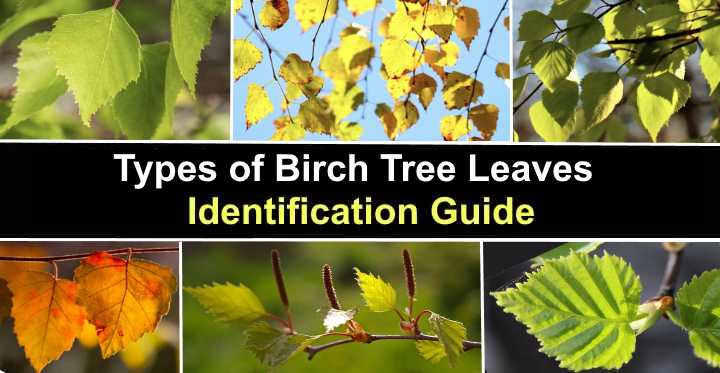
Birch tree leaves are known for their distinctive shape, texture, and veining patterns. Birch tree leaves are generally triangular or diamond-shaped with serrated margins, prominent veins, a slender petiole, and pointed tips. While birch tree leaves share common features, variations in their appearance aid in identifying distinct species.
This article is an identification guide to the different types of birch tree leaves. Descriptions and pictures of the leaves of various birch tree species will help you identify and distinguish between different types of birch trees.
How to Identify Birch Tree Leaves
To identify a birch tree by its leaves, look at the leaf shape, margin, veins, and color. Birch leaves are typically egg-shaped or triangular with a rounded base. Next, look at the serration along the edges. Lastly, look closely at the veining pattern and differences in color between the top and bottom surfaces.
Generally, birch leaves have a glossy sheen on the upper surface. They are arranged alternately on branches and measure 2” to 3” (5 – 7.5 cm) long. However, leaves on the yellow birch and sweet birch tree can grow up to 5” (10 cm) long.
Types of Birch Tree Leaves: Identification Guide With Pictures
Let’s look in more detail at the identifying features of the most common types of birch tree leaves you will likely come across.
Silver Birch Tree Leaves (Betula pendula)

Silver birch tree leaves
Silver birch tree leaves are distinctive triangular leaves with doubly serrated edges. Identifying features of the deciduous leaves are their long, tapered tips, glossy green texture, and prominent veins running laterally from the midrib. Silver birch leaves are relatively small, measuring 1.5” to 3” (4 – 7.5 cm) long with heart-shaped bases.
The upper side of silver birch tree leaves is a vibrant, glossy green. In the fall, the birch leaves turn a golden yellow color before dropping. The leaf underside is lighter and may be covered in fine hairs.
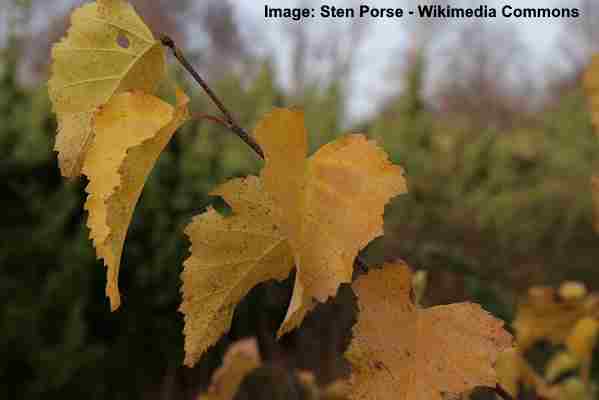
Silver birch autumn foliage
Other identifying features of the silver birch tree are its white, papery bark, pendulous or drooping branches, and greenish cylindrical clusters of flowers. Silver birch trees grow 30 to 50 ft. (10 – 15 m) tall and grow in a wide range of soil conditions.
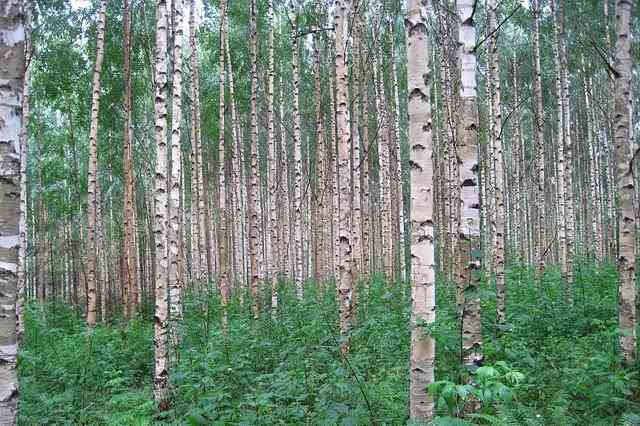
Silver birch bark
Paper Birch Tree Leaves (Betula papyrifera)

Paper birch tree leaves
Paper birch tree leaves are large, slender triangular blades with coarsely serrated margins. The birch leaves are also known for their ovoid shape with a tapering tip and glossy green texture. Additionally, the birch leaves have distinct veins running from the midrib to the teeth and a hairy underside.
Paper birch leaves measure 2” to 4” (5 – 10 cm) long.
The paper birch leaves are dull green with a shiny upper side in spring and summer. The leaves turn a golden yellow in the fall before dropping to the ground. Like all types of birch trees, the leaves are arranged alternately on branches. Compared to silver birch leaves, paper birch foliage is more slender with a deeper green color.
Apart from the triangular or egg-shaped, pointed leaves, the paper birch’s other features are its exfoliating white bark revealing orange inner bark, drooping cone-like flower clusters, and small, winged seeds.
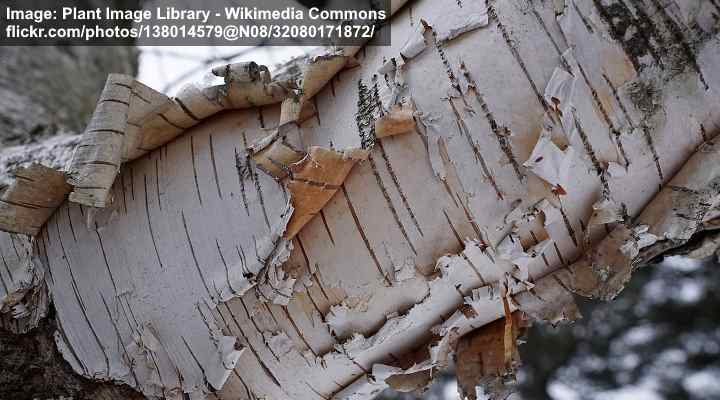
Paper birch tree bark
River Birch Tree Leaves (Betula nigra)
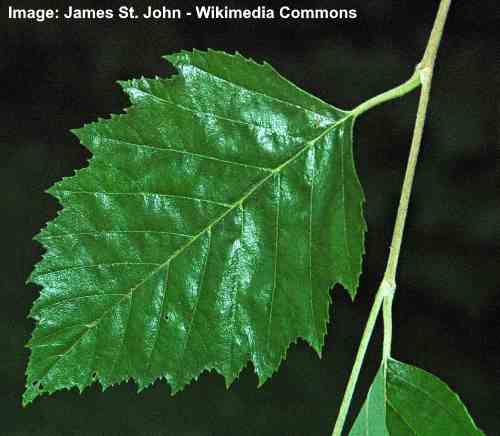
Close up picture of river birch tree leaf
River birch tree leaves are relatively small, deltoid-shaped (triangular) leaflets with double-serrated edges. The birch leaves are identified by their prominent parallel veins running from the midrib to the toothed edges. The blades have narrow tips and measure 2” to 4” (5 – 10 cm) long with a heart-shaped base.
The surface of the river birch leaves is light green and smooth to the touch, often with a glossy texture. The undersides of the leaves have a velvety feel and a lighter color. The deciduous leaves turn golden yellow in the fall before dropping.
Other identifying features of the fast-growing river birch tree are its pinkish-gray shaggy bark, greenish flowers, winged seeds, and symmetrical branching habit. River birch trees are relatively small, growing 40 to 60 ft. (13 – 18 m) tall.
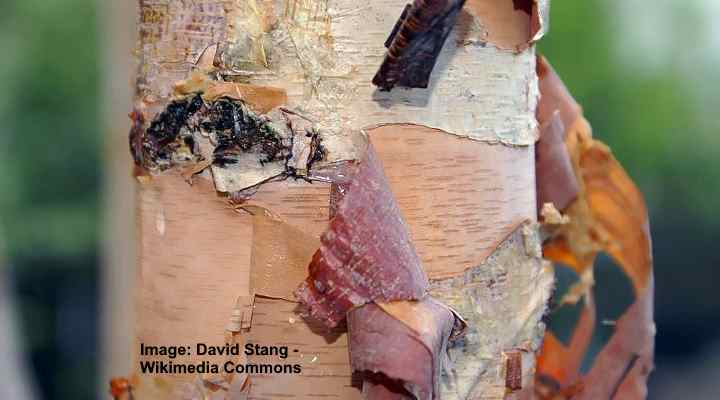
River birch tree bark
Cherry Birch Tree Leaves (Betula lenta)
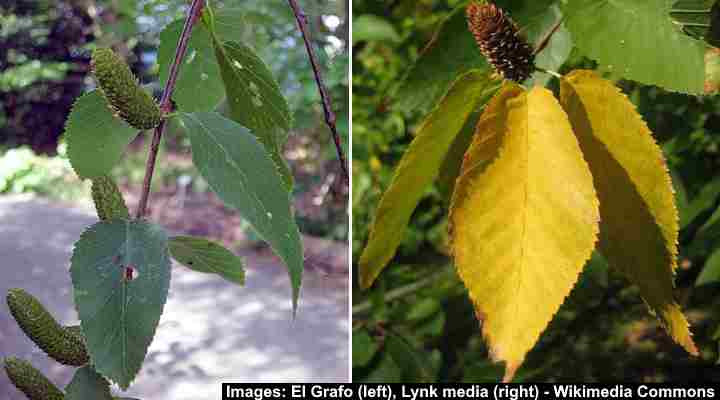
Cherry birch tree leaves
Cherry birch tree leaves are oval in shape with a pointed tip and single-toothed edges. The leaves have a smooth, glossy texture with a dark green color on the upper side, pressed veins, and a cordate (heart-shaped) base. Cherry birch leaves measure 2” to 6” (5 – 15 cm) long.
During summer, cherry birch leaves are yellowish-green. Unlike other species of birch trees, the leaves have a smooth underside. The leaves turn a vibrant golden-yellow color in fall before dropping from the tree.
Other identifying features of the cherry birch tree are its grayish bark with horizontal lenticels, reddish-brown twigs, clusters of cylindrical greenish flowers, and winged seeds. Cherry birch trees can grow 60 to 60 ft. (18 – 21 m).
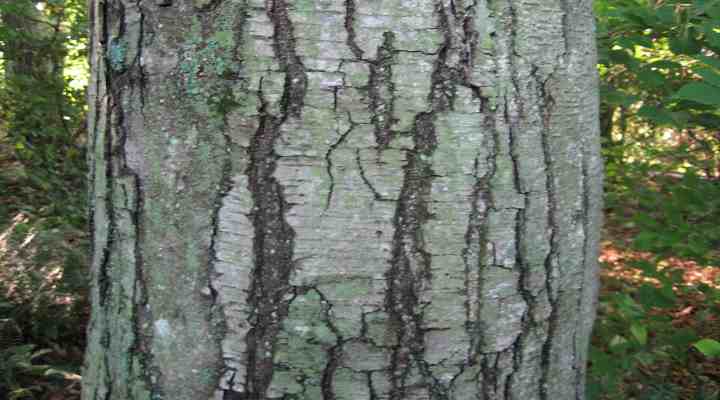
Cherry birch tree bark
Bog Birch Tree Leaves (Betula pumila)
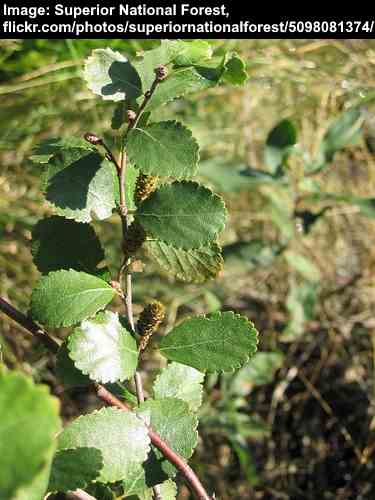
Bog birch tree leaves
Bog birch tree leaves are small, oval-shaped leaves with rounded teeth around the edges. The thick, leathery birch leaves are characterized by their smooth texture, dark green color, and silvery undersides. The birch leaves measure 1” to 2” (2.5 – 5 cm) long and have a distinctly rounded base and overall shape.
The bog birch leaves have a glossy appearance during the growing season. They also feature a distinct lighter-colored yellowish lateral venation. In the fall, they turn a bright yellow or yellow-orange color before dropping.
Other identifying features of the bog birch tree include its thin, peeling bark, small catkins, and winged seeds. Bog birch trees are typically low-growing shrub-like trees, reaching 3 to 6 ft. (1 – 2 m). They are commonly found in wetland areas such as bogs and swamps.
American Dwarf Birch Leaves (Betula glandulosa)
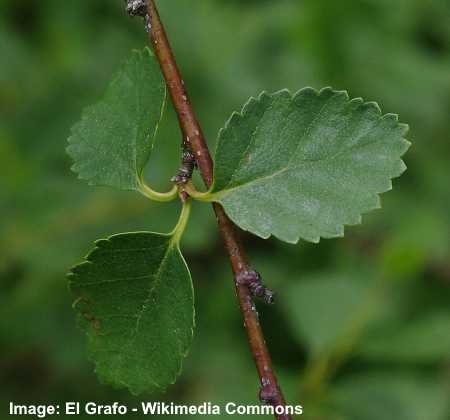
American dwarf birch leaves
American dwarf birch tree leaves are small and oval-shaped with rounded teeth around the edges. The thick, leathery leaves have a smooth texture and a glossy, bright green color contrasting with red stems. The birch leaves are 0.5” to 3” (1.2 – 3.8 cm) long and have rounded bases.
The American dwarf oval birch leaves grow alternately on stems and have a short petiole. They have a glossy appearance throughout summer before turning a vibrant yellow or orange in the fall.
The American dwarf birch is unique in that it’s a deciduous shrub. Apart from its oval, leathery leaves, the multi-stemmed shrub is identified by its brown bark, long upright catkins, and low height. American dwarf birch shrubs grow 1 to 3 ft. (0.3 – 1 m) tall.

American dwarf birch shrub
Gray Birch Tree Leaves (Betula populifolia)
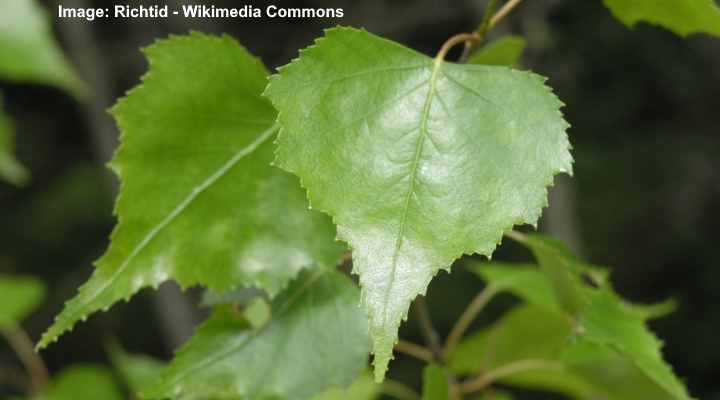
Gray birch tree leaves
Gray birch tree leaves are triangular with rough, doubly serrated edges. The leaves have a slender, tapering, pointed tip and a heart-shaped base. The birch leaves measure 1” to 2.5” (2.5 – 6.5 cm) long and attach to the branches on long petioles. This feature makes them dance in light breezes.
The gray birch tree leaves have a smooth, glossy texture and a light green color on the upper side. The undersides of the leaves are a lighter color and may have fine hairs. Noticeable are yellow veins that attach the midrib to the pointed teeth on the margins. The gray birch tree’s autumn foliage color is bright yellow.
Other identifying features of the gray birch tree are its thin white bark with black markings, yellowish-brown or orange twigs, drooping clusters of catkins, and small, winged seeds. Gray birch trees typically grow 20 to 40 ft. (6 – 12 m) tall.

Gray birch tree bark
Yellow Birch Tree Leaves (Betula alleghaniensis)

Yellow birch tree leaves
Yellow birch tree leaves are ovate or elliptic in shape with a pointed tip and fine, doubly serrated edges. The birch leaves have a smooth texture and a dark green glossy color on the upper side and yellowish underneath. Venation is pinnate, and the veins are dark green and pronounced.
Yellow birch leaves measure 3” to 5” (7.5 – 12.5 cm) long and have a rounded or slightly heart-shaped base. The tree’s fall foliage color is vibrant yellow or golden -yellow color before dropping.
Another identifying feature of the yellow birch tree is its yellowish-brown bark that peels in thin, papery layers. The tree also produces drooping catkins and small, winged seeds. Yellow birch trees can grow up to 80 ft. (24 m) tall and are commonly found in moist forests.
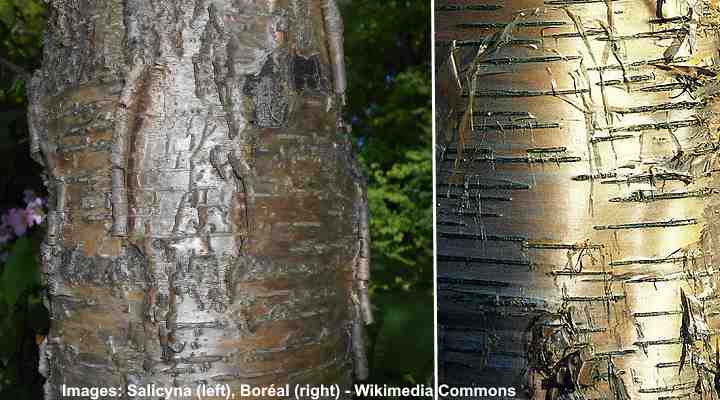
Yellow birch tree bark
Dwarf Birch Tree Leaves (Betula nana)
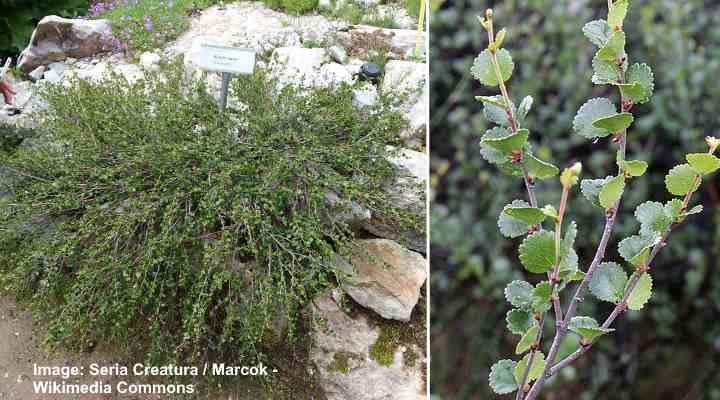
Dwarf birch shrub and a close up picture of the leaves
Dwarf birch is a shrub; its leaves are small and have an oval, almost circular shape with bluntly toothed edges. The birch leaves have a dark green color and a smooth texture. They measure approximately 0.25” to 0.8” (0.6 – 2 cm) in diameter and have a fairly straight base.
During the growing season, the dwarf birch leaves have a glossy appearance. In the fall, they turn rich red shades. The unusual, rounded birch tree leaves are also identifiable by their pointed, angled tips.
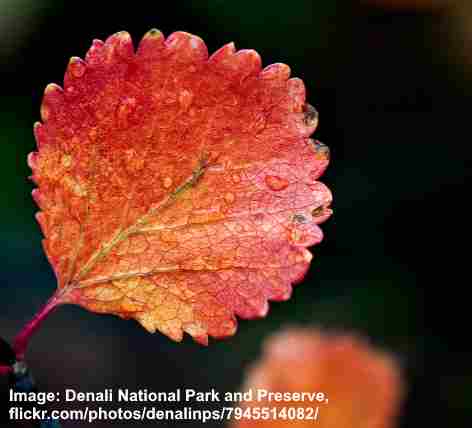
Dwarf birch autumn leaf
Other identifying features of the dwarf birch tree include its low-growing habit, small size, and clusters of small, cone-like flowers. Dwarf birch trees typically grow 1 to 3 ft. (0.3 – 1 m) tall. They are commonly found in colder climates of North America and Europe.
Water Birch Tree Leaves (Betula occidentalis or Betula fontinalis)

Water birch tree leaves
Water birch tree leaves are broadly ovate with blunt or sharp pointed serrated edges and wedge-shaped bases. The birch tree leaves feature eight to ten pinnate veins, angled from the midrib to teeth on the margins. The leaves have a smooth, glossy texture and are dark green in color.
Water birch leaves measure 1” to 3” (2.5 – 7.5 cm) long and have a rounded or slightly pointed tip. The upper side of water birch leaves is dark greenish yellow, while the underside is paler. The leaves typically turn yellow in the fall but can also be red or orange.
Other identifying features of the water birch tree are its reddish-brown bark with horizontal lenticels, drooping flower clusters, and small, winged seeds. Water birch trees typically grow 10 to 40 ft. (3 – 12 m) tall and are commonly found near ponds, streams, or boggy ground.
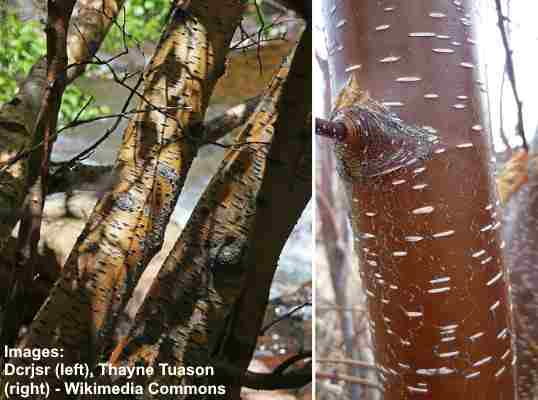
Water birch tree bark
Japanese White Birch Tree Leaves (Betula platyphylla var. japonica)
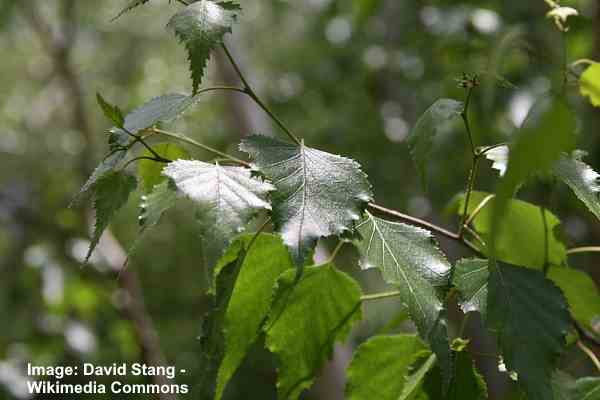
Japanese white birch tree leaves
Japanese white birch tree leaves are large, triangular blades with wavy, serrated edges, slender tips, and heart-shaped bases. The birch leaves measure 2” to 3” (5 – 7.5 cm) long and have a glossy green texture. Thin yellowish veins join the midrib to the toothed margins.
Japanese white birch leaves are vibrant green, grow densely, and are attached to the branches with long petioles. The fall foliage of Japanese white birch trees is a showy golden yellow.
Other identifying features of the Japanese white birch tree are its white bark that peels in papery layers, spreading branches, and pyramidal habit. Japanese white birch trees can grow 30 to 40 ft. (9 – 12 m) tall.
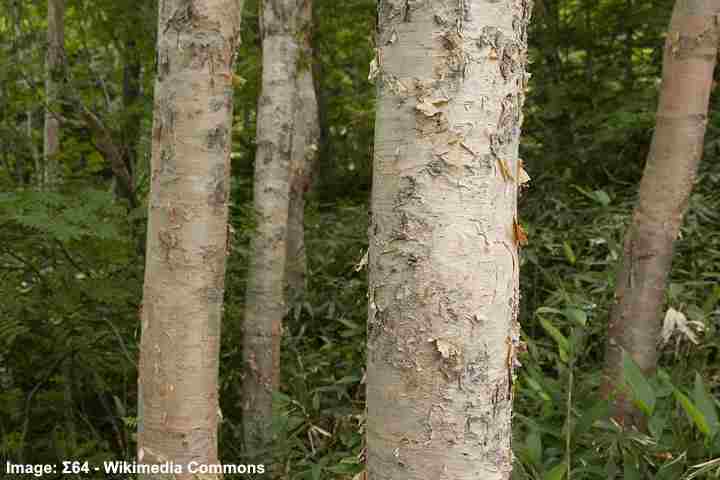
Japanese white birch tree bark
Himalayan Birch Tree Leaves (Betula utilis var. jacquemontii)
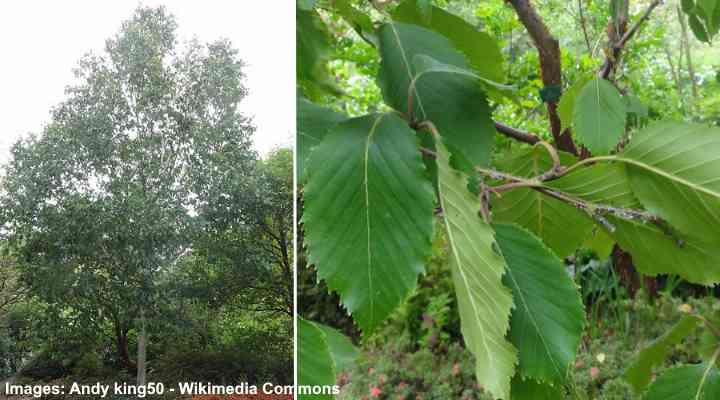
Himalayan birch tree and leaves
Himalayan birch tree leaves are oval to wedge-shaped blades with sharply serrated edges. The dark green leaves have a smooth texture and a dark green color on the upper side with a yellow midrib. The underside has prominent greenish-yellow veins. The birch leaves measure around 2” to 3” (5 – 7.5 cm) long and have a pointed tip.
The Himalayan birch tree’s fall foliage color is vibrant yellow before dropping. Like other birch trees, the leaves are arranged alternately on the branches.
Other identifying features of the Himalayan birch tree include its distinctive white bark that peels in papery layers, an upright, vase-shaped canopy, and catkin-like flower clusters. Himalayan birch trees can grow to 30 to 40 ft. (9 – 12 m) tall.

Himalayan birch tree bark
Downy Birch Tree Leaves (Betula Pubescens)
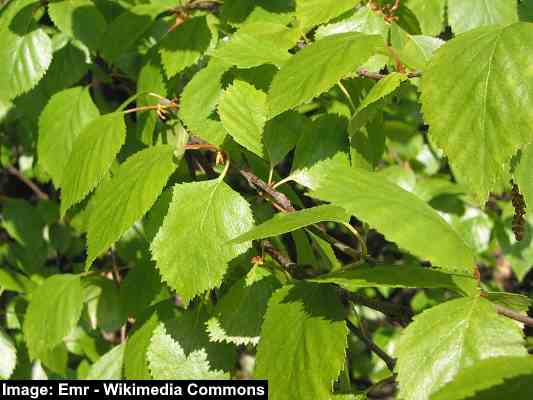
Downy birch tree leaves
The downy birch tree is identified by its small, triangular leaves with doubly serrated, uneven margins. The birch leaves have a pointed tip and a rounded to straight base. The leaves measure 0.8” to 2” (2 – 5 cm) long and 1.8” (4.5 cm) broad. As the tree’s name suggests, they have a downy texture on both sides.
The fall foliage color of downy birch leaves is yellow.
The downy birch tree is also identified by its white, papery bark, greenish-brown twigs, and young leaves and twigs covered in fine hairs. Downy birch trees can grow 30 to 65 ft. (9 – 20 m) tall and have upwardly spreading branches.
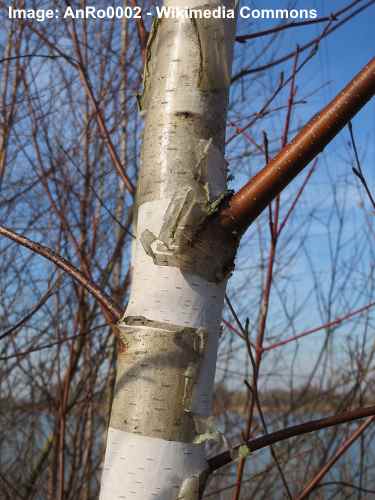
Downy birch tree bark
Chinese Red Birch Tree Leaves (Betula albosinensis)

Chinese red birch tree leaves
Chinese red birch tree leaves are identified by their oval shape and long, tapering apex. Like all birch leaves, these blades have finely serrated edges and prominent yellow venation. They also attach to branches with short petioles. The birch leaves emerge emerald-green before maturing to a distinctive sea green color.
Chinese red birch tree leaves measure 2” to 3” (5 – 7.5 cm) long and have a rounded base. They are glossy green during summer before turning a beautiful pale yellow in the fall.
An easily identifying feature of Chinese red birch trees is its smooth, reddish-brown to coppery-pink bark. Chinese red birch trees grow 30 to 50 ft. (9 – 12 m) tall.
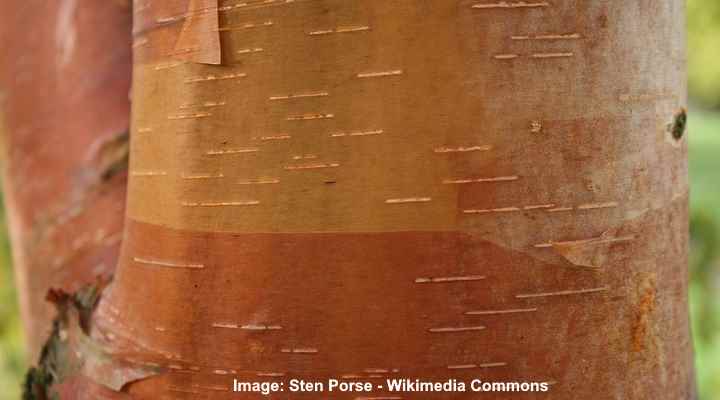
Chinese red birch tree bark
Monarch Birch (Betula maximowicziana)
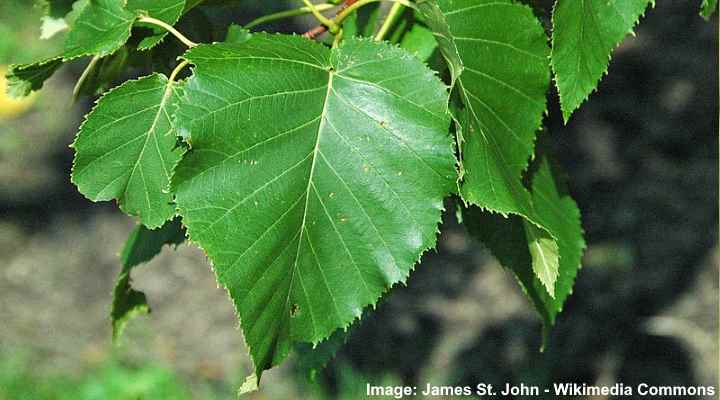
Monarch birch tree leaves
Monarch birch tree leaves have the largest leaves of all birch tree species. The spatulate-shaped leaves have a pointed tip and finely serrated edges. The birch leaves have a smooth texture and a dark green color on the upper side. The undersides are pale with prominent pinnate veins.
Monarch birch leaves are 3” to 6” (7.5 – 15 cm) long and have rounded bases. They have a soft texture throughout the growing season. Their fall foliage color is a vibrant yellow color before shedding from the tree.
It’s not just huge leaves that help identify the monarch birch tree; it is also a large tree—growing 80 to 100 ft. (24 – 30 m) tall. Another identifying feature of the monarch birch tree is its smooth, grayish-white bark peeling into large sheets.
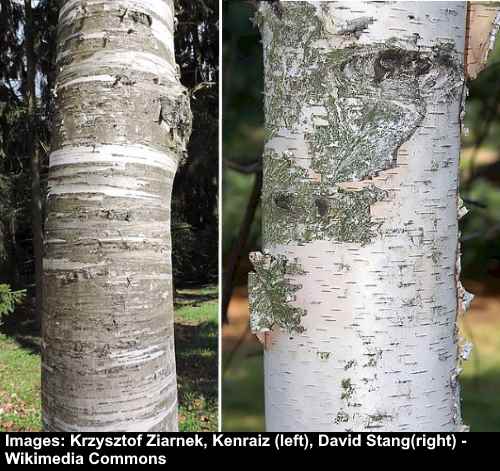
Monarch birch tree bark
Alaska Birch (Betula neoalaskana)
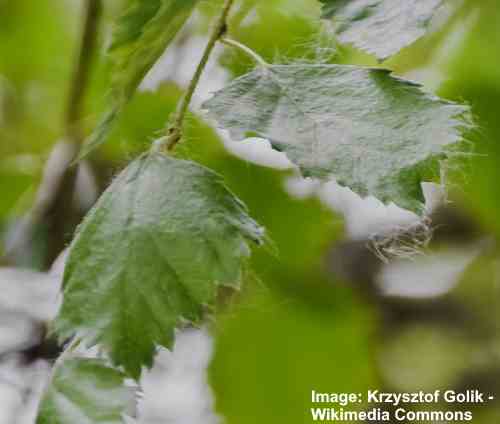
Alaska birch leaves
Alaska birch tree leaves are triangular to ovate blades with coarse, saw-toothed margins. The birch leaves measure 1” to 3” (2.5 – 7.5 cm) long and have a hairy appearance. These distinctive birch leaves have a tapering apex and sharp point. They have a glossy green upper side and paler whitish-silver underside with prominent veins.
The fall foliage color of Alaska birch leaves is a beautiful golden yellow shade.
Alaska birch trees can also be identified by their rough reddish-brown bark that matures to whitish pink. Typical of birch trees, its thin bark peels off in layers. The Alaska birch resembles the paper birch tree, only smaller in size, growing to 50 ft. (15 m) tall.

Betula neoalaskana bark
Birch Trees vs. Aspen Trees
Distinguishing between aspen and birch trees can sometimes be confusing due to their slender trunks, whitish silvery bark, and yellow autumn foliage. However, it’s important to note that aspens (genus Populus) and birch trees (genus Betula) belong to different plant families. Besides their family classification, there are additional contrasts in terms of bark and leaves that set aspens and birch trees apart.
What’s the Difference Between Aspen vs Birch Tree Leaves?
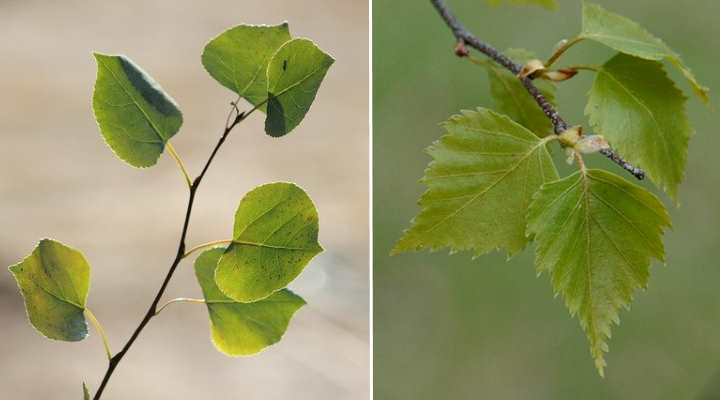
Aspen leaves (left) are usually rounder and shorter than birch leaves (right) and have less serrated edges
When comparing leaves of aspen and birch trees, there are distinct characteristics that set them apart. Aspen trees have flat, rounded leaves with a pointed tip and serrated edges. These leaves are wider, rounder, and shorter in comparison to birch leaves, displaying a finer toothed structure. Conversely, birch trees have lanceolate leaves that create a distinctive “V” shape, differing from the flatness of aspen leaves.
Birch vs. Aspen Tree Bark
You can also tell apart birch and aspen trees by their bark. Aspen bark becomes rough and fissured as the fast-growing tree matures. Birch tree bark is thin and papery and, unlike aspen trees, easily peels.
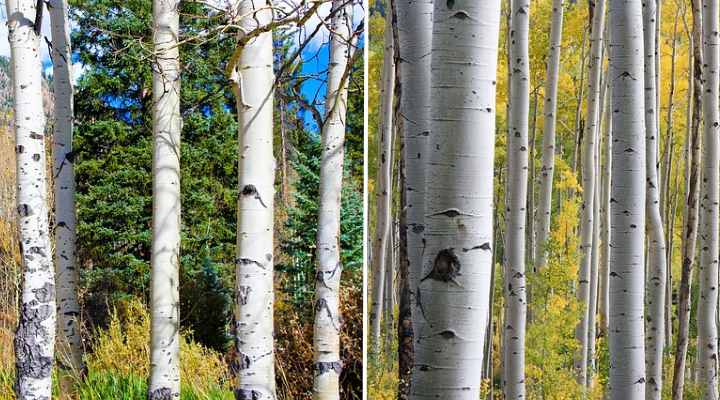
Aspen tree trunks (left) are very similar to birch trunks (right)
Related articles:
